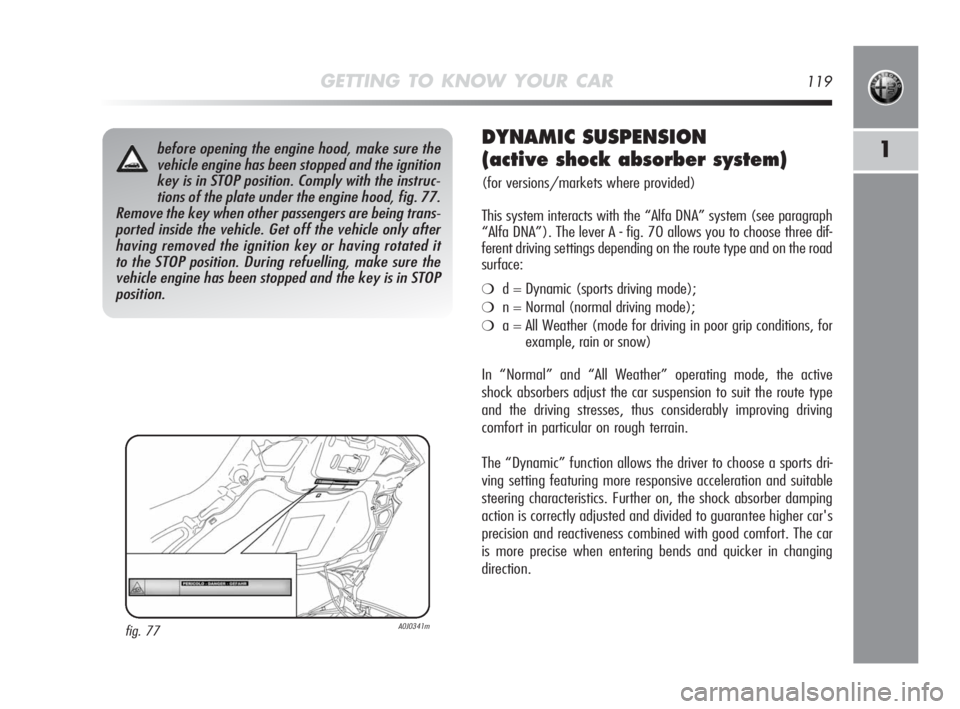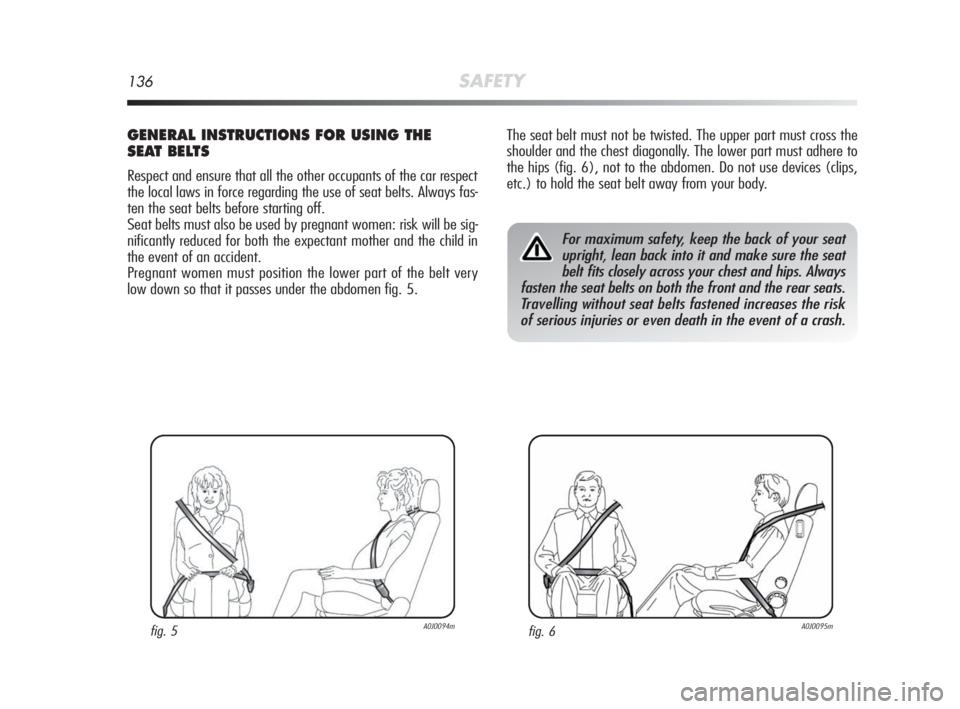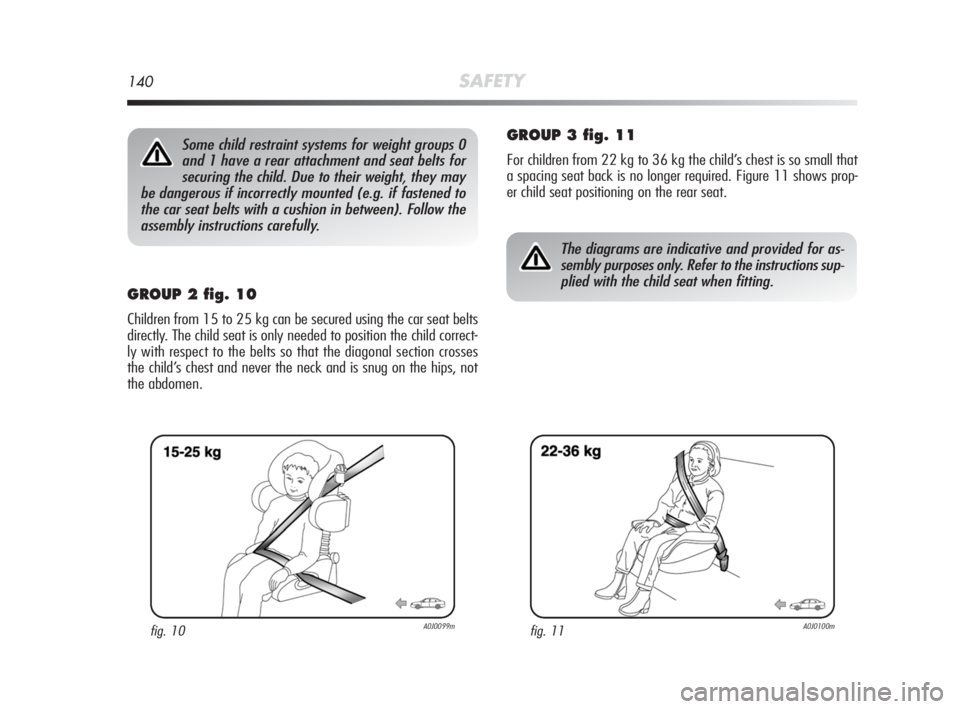ESP Alfa Romeo MiTo 2010 Owner handbook (in English)
[x] Cancel search | Manufacturer: ALFA ROMEO, Model Year: 2010, Model line: MiTo, Model: Alfa Romeo MiTo 2010Pages: 262, PDF Size: 6.32 MB
Page 112 of 262

GETTING TO KNOW YOUR CAR111
1“Alfa DNA” SYSTEM
(Dynamic vehicle control system)
(for versions/markets, where provided)
This device allows three different driving modes to be selected by
operating lever A-fig. 70 on the central tunnel.
❍d = Dynamic (sports driving mode);
❍n = Normal (normal driving mode);
❍a = All Weather (driving mode for poor grip conditions, i.e. rain
and snow on the road)
The device also acts on the dynamic vehicle control systems (en-
gine, steering, VDC system, instrument panel).
fig. 70A0J0090m
DRIVING MODES
Lever A-fig. 70 is a one-way switch, i.e. it always remains in the cen-
tral position. The selected driving mode is indicated by the corre-
sponding LED coming on in the panel and by an indication on the re-
configurable multifunctional display, as illustrated below:
A0J0227mA0J0290m
Dynamic Mode All Weather Mode
Normal Mode
When “NORMAL” mode is selected, no messages or symbols are
shown on the display.
VDCandASR: Standard calibration
Steering wheel tuning: Standard calibration
DST: Standard control of the brakes coordinated with ABS
Standard control of side acceleration
Steering wheel compensation: a slight pulse on the steer-
ing wheel tells on the driver to make a better manoeuvre
Engine: Standard response
001-130 Alfa MiTo GB 2ed 23-12-2009 12:36 Pagina 111
Page 113 of 262

112GETTING TO KNOW YOUR CAR
ENGAGEMENT/DISENGAGEMENT OF
“Dynamic” MODE
Engagement
Move lever A-fig. 70 upwards (to the letter “d”) and hold in this
position for 0.5 seconds until the corresponding LED lights up or
the word “Dynamic” appears on the display (see diagrams). Up-
on release, lever A returns to the central position.
Disengagement
To disengage “Dynamic” mode and return to “Normal”, move
the lever as described above once again. In this case, the LED cor-
responding to “Normal” mode will light up and the words “Normal
engaged” will appear on the reconfigurable multifunctional display
(see diagram).
A0J0186mA0J1055g
A0J1052g
VDCandASR: Sporty calibration, intervention only in the event
of loss of control
Steering wheel tuning: Sportier calibration
DST: Standard control of the brakes coordinated with ABS
More control of side acceleration
Steering wheel compensation: a slight pulse on the steer-
ing wheel tells on the driver to make a better manoeuvre
Engine: Higher response speed + Overboost to maximise torque
speed (where provided)In the 1.4 Turbo Multi Air versions, selecting the "Dynamic" oper-
ation mode activates the turbocharger supercharging function (over-
boost): depending on the accelerator pedal position and for a lim-
ited time, the engine management control unit allows the system
to generate maximum pressure levels inside the turbocharger and
the engine torque can reach higher values than usual. This function
is particularly useful whenever maximum performance is required
for a short time (e.g. when overtaking).
IMPORTANT When the "Dynamic" function is used, during acceler-
ation the steering may shudder, which is typical of a sports setting.
001-130 Alfa MiTo GB 2ed 23-12-2009 12:36 Pagina 112
Page 114 of 262

GETTING TO KNOW YOUR CAR113
1
ENGAGEMENT/DISENGAGEMENT
OF “All Weather” MODE
Engagement
Move lever A-fig. 70 downwards (to the letter “a”) and hold in
this position for 0.5 seconds until the corresponding LED lights up
or the word “All Weather” appears on the display (see diagrams).
A0J0187mA0J1180g
Disengagement
To disengage “All Weather” mode and return to “Normal”, carry
out the same procedure described for“Dynamic” mode, moving
lever A-fig. 70 to “a”.
IMPORTANT NOTES
❍It is not possible to go from“Dynamic” mode straight to “All
Weather” mode and vice versa. You must always first go back
to “Normal” mode and then select the other mode.
❍If “Dynamic” mode was engaged when the engine was
switched off, the next time it is started “Normal” mode is au-
tomatically selected. If, however, “All Weather” or “Normal”,
was engaged when the engine was switched off, the selected
mode is maintained the next time it is started.
❍“Dynamic” mode cannot be engaged at speeds of above
110 km/h.
❍In the event of system failure or a fault with lever A-fig. 70,
no driving modes can be selected. The display will show a
warning message.
VDCandASR: Calibration to ensure maximum safety
Steering wheel tuning: Standard comfort
DST: More control of the brakes coordinated with VDC
Standard control of side acceleration
Steering wheel compensation: a slight pulse on the steer-
ing wheel tells on the driver to make a better manoeuvre
Engine: Standard response
001-130 Alfa MiTo GB 2ed 23-12-2009 12:36 Pagina 113
Page 116 of 262

GETTING TO KNOW YOUR CAR115
1
ENGINE FAILED STOPPING CONDITIONS
When the system is operating, due to comfort, emission control
and safety reasons, the engine could not stop in some conditions,
among which:
❍still cold engine;
❍especially cold outside temperature;
❍insufficiently charged battery;
❍operating heated rear window;
❍windscreen-wiper operating at max. speed;
❍particulate filter (DPF) regeneration in progress (only for Diesel
engines);
❍open driver's door;
❍unfastened driver's seat belt;
❍engaged reverse (for example during parking manoeuvres);
❍for versions equipped with dual zone automatic climate control
(for versions/markets, where provided), if an adequate level
of thermal comfort has not been reached or MAX-DEF func-
tion activation;
❍during the first utilization period, for the system initialisation.
In these cases, the display shows a message and - for those ver-
sions/markets where it has been fitted - the
Usymbol on the
display flashes.
ENGINE RESTARTING CONDITIONS
Due to comfort, emission control and safety reasons, the engine
can be restarted automatically without any intervention by the
driver, under special conditions, such as:
❍insufficiently charged battery;
❍windscreen-wiper operating at max. speed;
❍low vacuum in the braking system (for example after repeat-
ed actions on the brake pedal);
❍moving vehicle (for example while driving downhills);
❍engine stopping by Start&Stop system for over 3 minutes;
❍for versions equipped with dual zone automatic climate control
(for versions/markets where provided), to enable suitable ther-
mal comfort or MAX-DEF function activation.
With engaged gear, the engine automatic restarting is possible
only by fully pressing the clutch pedal. The driver is informed by
the displaying of a message and - for versions/markets where it
has been fitted - by the flashing of the
Usymbol on the display.
Notes
If the clutch is not pressed, after 3 minutes from the engine stop-
ping, the engine can be restarted only by the ignition key.
In case of undesired engine stopping conditions, for example as a
result of sudden clutch pedal release with engaged gear, if the
Start&Stop system is active, the engine can be restarted by fully
pressing the clutch pedal or placing the gearbox in neutral.
If temperature comfort is to be preferred, deac-
tivate the Start&Stop system to make the climate
control system work continuously
001-130 Alfa MiTo GB 2ed 23-12-2009 12:36 Pagina 115
Page 120 of 262

GETTING TO KNOW YOUR CAR119
1before opening the engine hood, make sure the
vehicle engine has been stopped and the ignition
key is in STOP position. Comply with the instruc-
tions of the plate under the engine hood, fig. 77.
Remove the key when other passengers are being trans-
ported inside the vehicle. Get off the vehicle only after
having removed the ignition key or having rotated it
to the STOP position. During refuelling, make sure the
vehicle engine has been stopped and the key is in STOP
position.
fig. 77A0J0341m
DYNAMIC SUSPENSION
(active shock absorber system)
(for versions/markets where provided)
This system interacts with the “Alfa DNA” system (see paragraph
“Alfa DNA”). The lever A - fig. 70 allows you to choose three dif-
ferent driving settings depending on the route type and on the road
surface:
❍d = Dynamic (sports driving mode);
❍n = Normal (normal driving mode);
❍a = All Weather (mode for driving in poor grip conditions, for
example, rain or snow)
In “Normal” and “All Weather” operating mode, the active
shock absorbers adjust the car suspension to suit the route type
and the driving stresses, thus considerably improving driving
comfort in particular on rough terrain.
The “Dynamic” function allows the driver to choose a sports dri-
ving setting featuring more responsive acceleration and suitable
steering characteristics. Further on, the shock absorber damping
action is correctly adjusted and divided to guarantee higher car's
precision and reactiveness combined with good comfort. The car
is more precise when entering bends and quicker in changing
direction.
001-130 Alfa MiTo GB 2ed 23-12-2009 12:36 Pagina 119
Page 126 of 262

GETTING TO KNOW YOUR CAR125
1
GENERAL WARNINGS
During parking manoeuvres, pay the utmost attention to any ob-
stacles that could be located above or below the sensors.
Sometimes, objects located close to the rear part of the vehicle
may not be detected by the system and may damage the vehicle
or become damaged themselves.
The ultimate responsibility when parking and car-
rying out other dangerous manoeuvres still rests
with the driver. When carrying out such manoeu-
vres, always ensure that the manoeuvring area is free
of people (particularly children) and animals. Parking sen-
sors are designed to assist drivers: in all cases, you must
always pay the utmost attention during potentially dan-
gerous manoeuvres, even when these are carried out at
low speed.Here below are some conditions that may influence the perfor-
mance of the parking system:
❍reduced sensor sensitivity and reduced parking aid system per-
formance could be caused by the presence of the following
on the sensors: ice, snow, mud, multiple layers of paint;
❍the sensors detect objects that are not there (“echo disturbance”)
caused by mechanical disturbances, for example: washing the
car, rain (extreme wind conditions), hail;
❍the indications sent by the sensors can also be altered by the
presence of ultrasound devices (e.g. pneumatic brake systems
or pneumatic drills) near the car;
❍sensor performance can also be influenced by the position of
the sensors. For example by a change in the ride setting (caused
by the wear of the shock absorbers, suspension), overloading
the vehicle and carrying out specific tuning operations that re-
quire the vehicle to be lowered;
❍the detection of obstacles to the upper part of the vehicle is not
guaranteed as the system is designed to detect obstacles that
could impact the lower part of the vehicle.
001-130 Alfa MiTo GB 2ed 23-12-2009 12:36 Pagina 125
Page 137 of 262

136SAFETY
The seat belt must not be twisted. The upper part must cross the
shoulder and the chest diagonally. The lower part must adhere to
the hips (fig. 6), not to the abdomen. Do not use devices (clips,
etc.) to hold the seat belt away from your body.GENERAL INSTRUCTIONS FOR USING THE
SEAT BELTS
Respect and ensure that all the other occupants of the car respect
the local laws in force regarding the use of seat belts. Always fas-
ten the seat belts before starting off.
Seat belts must also be used by pregnant women: risk will be sig-
nificantly reduced for both the expectant mother and the child in
the event of an accident.
Pregnant women must position the lower part of the belt very
low down so that it passes under the abdomen fig. 5.
For maximum safety, keep the back of your seat
upright, lean back into it and make sure the seat
belt fits closely across your chest and hips. Always
fasten the seat belts on both the front and the rear seats.
Travelling without seat belts fastened increases the risk
of serious injuries or even death in the event of a crash.
fig. 6A0J0095mfig. 5A0J0094m
131-152 Alfa MiTo GB 2ed:131-152 Alfa MiTo GB 23-12-2009 12:37 Pagina 136
Page 141 of 262

140SAFETY
GROUP 2 fig. 10
Children from 15 to 25 kg can be secured using the car seat belts
directly. The child seat is only needed to position the child correct-
ly with respect to the belts so that the diagonal section crosses
the child’s chest and never the neck and is snug on the hips, not
the abdomen.
GROUP 3 fig. 11
For children from 22 kg to 36 kg the child’s chest is so small that
a spacing seat back is no longer required. Figure 11 shows prop-
er child seat positioning on the rear seat.
fig. 10A0J0099mfig. 11A0J0100m
The diagrams are indicative and provided for as-
sembly purposes only. Refer to the instructions sup-
plied with the child seat when fitting.
Some child restraint systems for weight groups 0
and 1 have a rear attachment and seat belts for
securing the child. Due to their weight, they may
be dangerous if incorrectly mounted (e.g. if fastened to
the car seat belts with a cushion in between). Follow the
assembly instructions carefully.
131-152 Alfa MiTo GB 2ed:131-152 Alfa MiTo GB 23-12-2009 12:37 Pagina 140
Page 156 of 262

STARTING UP AND DRIVING155
3
In the initial period of use, it is advisable to avoid
placing the car under excessive stress (for instance
excessive acceleration, extended travel at maxi-
mum speed, sharp braking etc.).
Remember that the servo brake and electric pow-
er steering are not operational until the engine has
been started, therefore more effort than usual is
required on the brake pedal and steering wheel.
Avoid jump starting the engine by pushing, towing
or driving downhill. These manoeuvres may dam-
age the catalytic converter.
When the engine is off, do not leave the key in
the ignition switch turned to MAR to avoid drain-
ing the battery.
HOW TO WARM UP THE ENGINE AFTER IT HAS
JUST STARTED (petrol and diesel engines)
Proceed as follows:
❍drive off slowly, letting the engine turn at medium speed. Do
not accelerate abruptly;
❍do not demand maximum performance for the first few kilo-
metres. Wait until the engine coolant gauge starts moving.
EMERGENCY START
If the Ywarning light in the instrument panel remains on con-
stantly, contact an Alfa Romeo Authorised Service Provider.
STOPPING THE ENGINE
Turn the ignition key to STOP while the engine is idling.
IMPORTANT After a taxing drive, before turning the engine off you
should allow it to idle to allow the temperature in the engine com-
partment to fall.
A quick burst on the accelerator before turning off
the engine serves absolutely no practical purpose,
it wastes fuel and is damaging, especially to tur-
bocharged engines.
153-162 Alfa MiTo GB 2ed:153-162 23-12-2009 12:37 Pagina 155
Page 161 of 262

160STARTING UP AND DRIVING
Acceleration
Sudden acceleration has a very negative effect on fuel consump-
tion and emissions: accelerate gradually and do not go over the
maximum torque ratio.
CONDITIONS OF USE
Cold starting
Short distances and frequent cold start-ups will prevent the en-
gine from reaching optimal running temperature. Consequently,
both fuel consumption (from +15 to +30% on an urban cycle )
and emissions will increase.
Traffic and road conditions
Rather high fuel consumption is caused by heavy traffic, for instance
when travelling in a queue with frequent use of low gears or in
cities with many traffic lights. Mountain and rough roads also have
a negative effect on fuel consumption.
Traffic hold-ups
During prolonged hold-ups (level crossings) the engine should be
switched off.
TOWING TRAILERS
IMPORTANT NOTES
The vehicle must be provided with a type-approved tow hook and
adequate electrical system to tow caravans or trailers. Installation
must be carried out by a specialist.
Install any specific and/or additional rear-view mirrors as specified
by law.
Remember that when towing a trailer, steep hills are harder to
climb, braking distances increase and overtaking takes longer de-
pending on the overall weight.
Engage a low gear when driving downhill, rather than constantly
using the brake.
The weight of the trailer reduces the load capacity of the vehicle
by the same amount. Consider the weight of the fully-laden vehi-
cle weight, including accessories and luggage, to make sure you
do not exceed the maximum towable weight (shown on the reg-
istration certificate).
Respect the speed limits specific to each country for vehicles tow-
ing trailers. In any event do not exceed 100 km/h.
153-162 Alfa MiTo GB 2ed:153-162 23-12-2009 12:37 Pagina 160